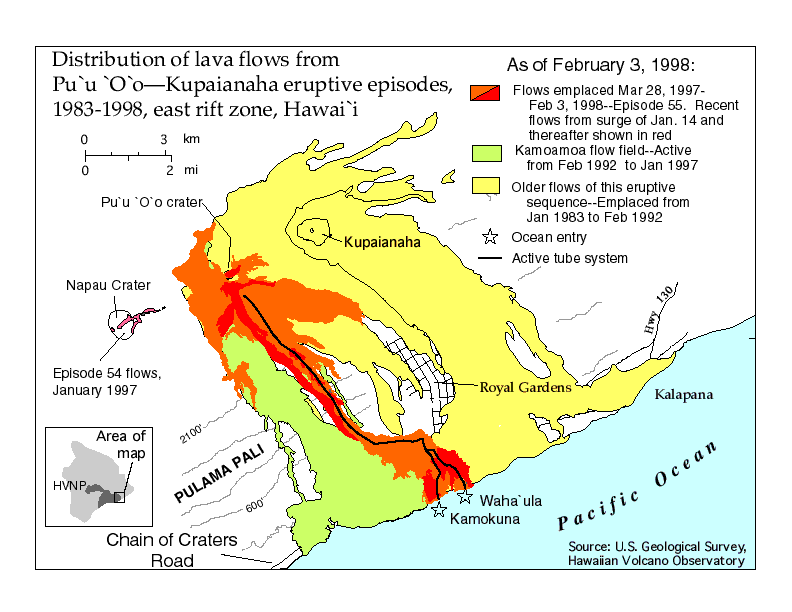Photo and Video Chronology - Kilauea - February 4, 1998
In the aftermath of a surge. Surge of magma from Kilauea's summit downrift to Pu`u `O`o on January 14; Kilauea Volcano's east rift zone only now returning to a typical pattern of behavior.
[This update current as of February 4, 1998. Eruption updates are posted approximately every two weeks. More frequent updates will accompany drastic changes in activity or increased threat to residential areas.}
On January 14 at 6:15 p.m., a surge of mama disturbed the upper crust beneath Kilauea caldera. Immediate effects, occurring in the subsequent 12 hours, included a swarm of earthquakes (mostly magnitude 1-2, largest 2.2) at the summit of Kilauea and discharge of lava from vents on the south side of Pu`u `O`o, 17 km to the east. The earthquakes and surge disturbed the equilibrium of the eruption, an effect only now subsiding as the eruption returns to a pattern more typical of previous months. All these events are part of Episode 55, the eruptive episode that began February 24, 1997, and is continuing today. If you wish to learn more of the seismic, tilt, and eruptive events that occurred January 14-16, check the Jan. 17 archive.
In the three weeks since January 14th
- The summit of Kilauea Volcano has slightly inflated and deflated several times over periods of hours to days. In contrast, during previous months the summit typically showed only minor changes as the eruption proceeded in a more steady-state routine.
- Supply of lava to the tube system was interrupted at least twice, coincident with episodes of summit inflation and deflation.
- At the coast, the dwindling supply of lava to the tube system resulted in diminished discharge of lava to the ocean. Consequently, the steam plumes that commonly billow from the lava-water interface periodically weakened and vanished for a day or two at a time.
- Beginning at 5:39 p.m. on January 27 and persisting into January 28, a swarm of earthquakes struck the area beneath Namakani Paio campground, 2 km northwest of Kilauea Volcano's summit. Several of these earthquakes rattled houses in the area and were felt from Hilo to Ocean View Estates, sites 40-50 km from the epicenter. The largest earthquake of the sequence, magnitude 4.4, occurred shortly after 8:00 p.m. on January 27.
The most obvious change visible to visitors at the National Park has been the numerous breakouts of lava along the coastal plain. In the days and weeks following the January 14 surge, fluctuating lava supply to the tube system periodically overwhelmed the tubes. On these occasions, lava upwelled, punched through weak zones in the tubes' roofs, and spread slowly outward on the ground surface. The coastal plain is highly subject to such breakouts because the tubes approach the plain by traversing down high, steep slopes. Elevation contrasts of nearly 500 m create substantial hydraulic head, adding additional force to lava when it fills the tubes.
Eruption-viewing opportunities change constantly, so those readers planning a visit to the volcano should contact Hawai`i Volcanoes National Park for the most current eruption information (808-985-6000). Additional photographs and descriptions of east rift eruptive activity may be found on the University of Hawai`i's web site.
Get Our News
These items are in the RSS feed format (Really Simple Syndication) based on categories such as topics, locations, and more. You can install and RSS reader browser extension, software, or use a third-party service to receive immediate news updates depending on the feed that you have added. If you click the feed links below, they may look strange because they are simply XML code. An RSS reader can easily read this code and push out a notification to you when something new is posted to our site.








